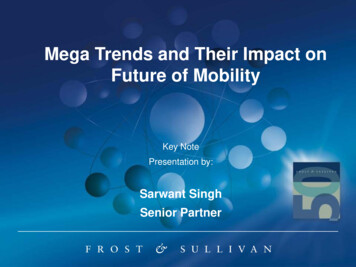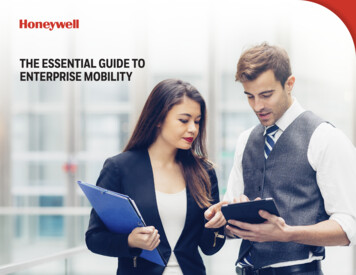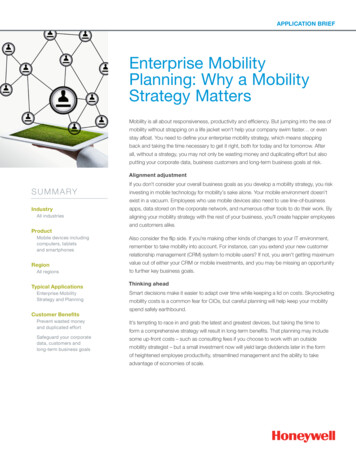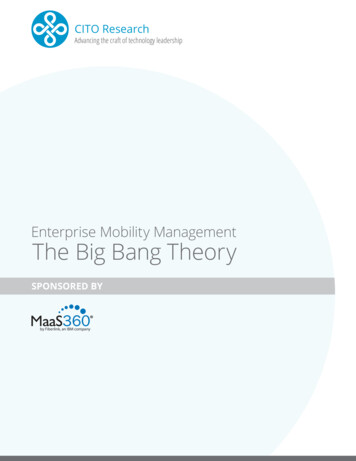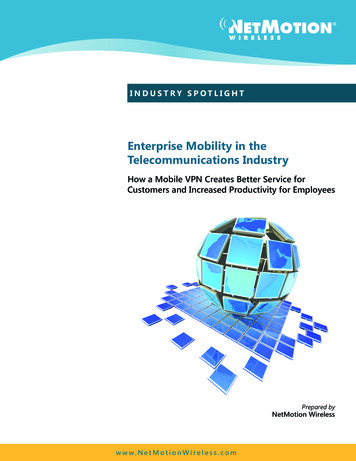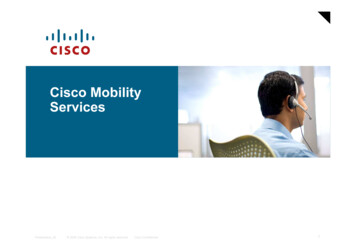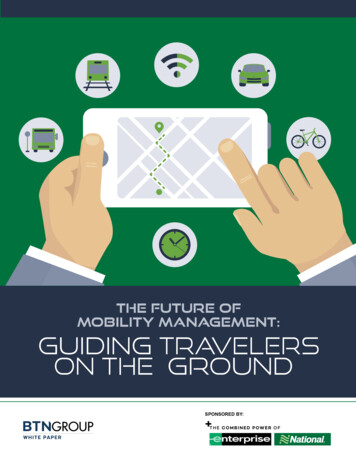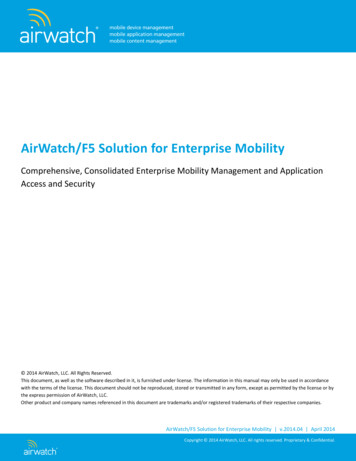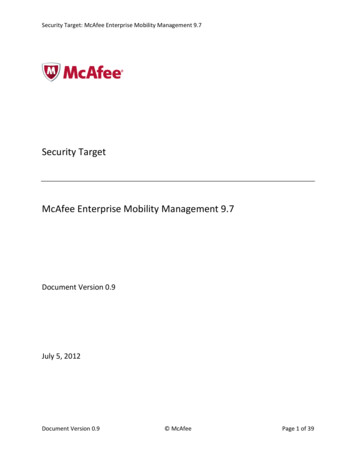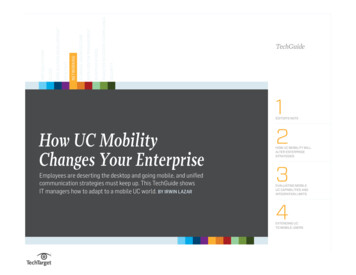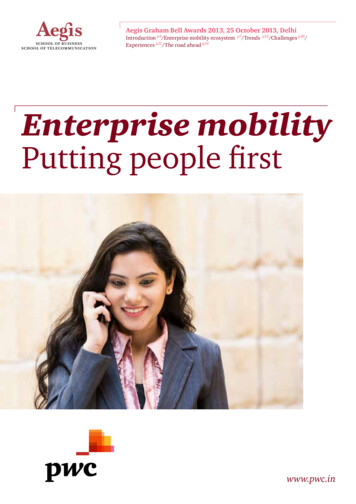
Transcription
Aegis Graham Bell Awards 2013, 25 October 2013, DelhiIntroduction p4/Enterprise mobility ecosystemExperiences p21/The road ahead p24p7/Trendsp12/Challenges p20/Enterprise mobilityPutting people firstwww.pwc.in
We are perhaps living in the best times in terms of connectivity when out of the total seven billion, sixbillion people are connected to each other through mobile phones. However, the full potential of thispower is yet to be explored.As the work force is becoming increasingly mobile and the consumers no longer like to wait for what theywant, enterprises are gearing up to harness this power for a competitive advantage. They have realizedthe perks of ‘putting people first’ and they are now not only providing mobile phones to their employees,they are even and making apps for their customers. Enterprise mobility is gaining considerablemomentum with the empowerment of both the employees and customers resulting in significanteconomic gain.We at Aegis, first experienced the power of mobile phones in a well connected world when we launchedmMBA (which is MBA on tablets) in 2011. It took the learning from the classrooms to the palm of ourstudents which were mainly working professionals in telecom companies. ‘Wherever-whenever’ and ‘mytime-my place’ are our two concepts that helped them balance between work and the learning process.They are now able to access their study material on their tablets while travelling which results in aneffective utilisation of their time. Within three years we reached from New Mumbai to other Indiancities and countries like Africa, Maldives, the Middle East, Afghanistan, Indonesia and Philippine. Themobility of our platform eliminated the location barrier for the faculty members and they were able toteach their students from different parts of the world from the living rooms. This further helped Aegis inaddressing the challenges of a growing cost, unavailability of faculty, scale, relevance and effectiveness.This year, we saw a good number of amazing innovations in the enterprise mobility area presented atAegis Graham Bell Awards by Indian as well international companies. These innovations have the powerto revolutionise business and bring the customer to centre stage.We believe that this joint report of Aegis and PwC will help the Indian enterprises to embrace ‘EnterpriseMobility’.Bhupesh DaheriaFounder, Aegis Graham Bell AwardFounder, mUniversityCEO, Aegis School of Business
The game of the future is about employee efficiency,effectiveness and quality—how can my employees reactfaster, have improved and quicker access to information,and can demonstrate high level of commitments to theirclients wherever they happen to be; all through the powerof a computing device in their hands.- Sivarama Krishnan, Executive Director, PwC IndiaDear friend,Not far from where my office is in Gurgaon, are the India headquarters of the world’s leading FMCGcompany. In a casual meeting with the CEO, I asked him what made his company’s businesses in allgeographies and across every product category, such a huge success.“We really put people first”,he said,and laid special emphasis on the ‘really’.I wonder how many business leaders can make such an emphatic claim on behalf of their organisations.Fortunately, today, more than ever before, this is so much easier. A deeper understanding of theemployees, partners and clients, an improved technology and well established processes together enablethe organisations to become people advocates. With respect to technology, organisations today areembracing enterprise mobility in more ways than one to ‘really put people first’. In a recent survey byPwC on emerging technologies and their impact, an overwhelming majority of C-suites polled citedenterprise mobility as the most important game changer for their businesses. Through this report, PwChas defined the broad contours of enterprise mobility in India: the ecosystem, the emerging trends,challenges and the overall opportunity for businesses. I wish to remind you that the future of smarterbusinesses will continue to rest with the smart people; our employees, partners and clients. While theenterprise mobility movement has been evolving around technology, processes, users etc., it is only nowthat organisations are beginning to adopt an integrated approach towards using enterprise mobility asa tool to enhance employee productivity and satisfaction.While technology has been the main stay for the gradual adoption of enterprise mobility solutionsby organisations in the country, today they are significantly taking a more people centric view toarchitecting their enterprise mobility ecosystem. This is a pleasant surprise and implies that we willwitness hyper growth in enterprise mobility as it gets dimensioned on need and requirements ratherthan capabilities.Aptly, this report focuses on the key areas that will inform decision making in the adoption anduse of enterprise mobility solutions in the years to come. It provides a comprehensive view on howorganisations can leverage enterprise mobility for creating value.Sivarama Krishnan,Executive Director,PricewaterhouseCoopers Pvt. Ltd.
IntroductionAs we publish this report, the Indianeconomy is going through one of its mostdifficult times. The downfall of the rupee,challenges with the land reforms billslowing FDI, shortage of FII money inIndia’s secondary markets and thechanges to the rule books are allresponsible for the worsening economicsentiment in the country.Understandably, corporate India isresponding very aggressively albeit notalways wisely to these developments.Most companies are actively working attaking out costs to improve margins inwhat is clearly a very challenging marketcondition. Measures announced by IndiaInc. include saving on travel andadministrative expenses, retrenchment ofnon performing or under-performingemployees, outsourcing the non-coreactivities, selling off the non-corebusinesses and operational improvementsresulting in efficiency gains, reduction inwastage and a better utilisation of assets.These bottom line focused measuresclearly demonstrate that the marketsentiment for a recovery is low anddistant. In the wake of this, organisationsare trying to find solutions that will enableimproved performance at lowerinvestments. One important area thatseveral leading organisations arefocussing on is enterprise mobility.Enterprise mobility, wherein, theorganisation enables employees, partnersand customers to access and work onorganisational technology platforms andwhere enablers through any devicetablets, laptops (personal) and smartphones, seamlessly through a securevirtual environment are gaining ground.Technology and market forces are the twoimportant facets of enterprise mobility.Technology is thrusting for ubiquitouscomputing and consumerisation oftechnology while the market forces arefocussed on exploration and adoption ofnew business models and being moreagile. Technology with key drivers likehyper competition, globalisation, digitisedprocesses and a scarcity of the ‘right skills’is making a compelling case for enterprisemobility.
The interplay of market and industry forces is driving companies to consider newbusiness modelsMarket ForcesIndustry ousComputingGlobalFocusNew BusinessModelsConsumerisationof technologyPrice WarsPressure to bemore agileDeliveryExcellenceSource: PwCEnterprise mobility is not a new thing. Infact, it took its very first fledgling stepsway back in the 1980s with the roll-out ofthe first company-wide telephonicnetworks. Over the years, the concept hasbecome more encompassing. Threegenerations of enterprise mobility havebeen identified. In the 1980s-1990senterprise mobility came to be identifiedwith voice communication through landline phones in conjunction with the use offacsimiles and telegraphs. In the1990s-2000s enterprise mobility moved tothe mobile platform through pagingsystems followed by early stage of themobile phones. Application levelenterprise mobility is, however, a fairlyrecent phenomenon. It started in 2007when the improvements in security andtechnology platforms enabled access tocorporate applications.
Generations of enterprise ine phones ile messaging capabilityemerges on cellular phonesApplication-centricphones arrive (2007)Better security againsteavesdropping and fraudbetter performanceBetter security andaccess to corporatemessaging server-basedPIM applicationsBetter security andaccess to corporateapplicationsIntroduction todigital cellularIntroduced enterprisewireless e-mail andcalendaring (1099)Upgraded security(2009-10) End-to-end dataencryption Remote wipe E AS policy supportSecurity model derivedfrom the features of thesecond generation, but onall major OSes (2011-12)Subscriber-based IDand authenticationSource: PwC analysisInterestingly, in its third generation,enterprise mobility has matured tobecome hardware independent and thefocus has come to the front end userinterfacing applications. This comparesfavourably to the focus on back end andmiddle-ware technological capabilities inearlier generations and is in sync with thetimes.Application centricity is resulting in agilitydriving greater adoption of enterprisemobility solutions. Security, which is amajor issue impeding adoption, has cometo the centre stage. There is a plethora ofsolutions to provide peace of mind to theusers, corporate and individuals alike.Significantly, the third generation ofenterprise mobility solutions aresuccessfully generating confidence withthe leaders, resulting in quicker adoption.In this report, we delve on the myriadcomponents, the challenges and thebenefits of enterprise mobility. The reportaims to engage and educate our readerson the significance of this movement, itsramifications for organisational cultureas well as opportunities available to beharnessed on its account.
Understanding theenterprise mobilityecosystemAn ecosystem is defined as ‘everythingthat exists in a particular environment’. Incase of enterprise mobility it would consistof everything that is required to make itwork. There are seven key components inthe enterprise mobility ecosystem. Theseinclude: Users: The organisations, employees,vendors, partners and customers arethe key stakeholders in any enterprisemobility solution. The following arethe three key drivers for thiscomponent:–– Business need: Organisationsneed to provide access to enterprisesystems to the internal andexternal stakeholders to ensureenhanced responsiveness, higheravailability, improved performanceand overall satisfaction.–– Personal need: Individualstakeholders need access to theenterprise systems both from theperspective of improved access andround the clock availability.Enterprise mobility is an importanttool for enhancing individualengagement and satisfactionwithin the enterprise.–– Experience: Experience is animportant factor that impacts theusers of enterprise mobilitysolutions. Organisations have tocreate a seamless experience basedon quality interfaces, low latenciesand empowered access to data fromwithin the enterprise. Security: The safety andconfidentiality of data available withinand through enterprise mobilitysolutions is of paramount importance.Following are the three key drivers ofthis component:–– Authentication: ‘How do I ensurethat the right person is accessing mysystems and data therein?’ is aquestion that most technologyofficers within companies struggle toanswer. The ‘who’, ‘what’, ‘where’,‘when’ and ‘how’ of ensuring fast,accurate and regular authenticationis paramount for securing enterprisemobility solutions.–– Encryption: ‘How do I control theaccuracy, confidentiality and overallsecurity of my data duringtransmission?’ is an importantquestion that organisations arebesieged with. Multiple technologiesfor encryption are being tested anddeployed to ensure greater stabilityin securing enterprise mobilitysolutions.–– Security policy: ‘How do I ensurethat a culture of security is imbuedby all my stakeholders?’Organisations want employees,vendors, partners and customers towork with them for helping themrealise a security oriented culture.The key to this is defining andpublishing security policies andmonitoring adherence to these.Institutionalisation of securitypolicies governing device use,content, access rights and dataprivacy are helping organisationsenhance sensitivity towards bestpractices in security for bothinternal and external stake holders.
Devices: Devices are an integral partof enterprise mobility solutions.These include all types of devicesthrough which enterpriseapplications and systems areaccessible to both internal andexternal stakeholders. For instance,desktops, laptops, tablets andsmartphones. The selection,procurement, certification,configuration, provisioning andmanagement of devices critical forthe success of enterprise mobilityarchitecture within an organisation.Several enterprises are adopting amore flexible approach to devicesthrough the ‘bring your own device’(BYOD) policies, wherein enterprisesare comfortable with providingstakeholders access to enterprisesystems through individually owneddevices. Governance: Smart enterprises areestablishing robust governancemechanisms encompassing strategy,best practices and policies formanaging the enterprise mobilityecosystem. A clearly articulatedstrategy establishing the need, the visionand the tactical road map for achievinggoals for enterprise mobility is critical tosteer the organisation through unforeseencircumstances. Governance model ensuresthat the boundary conditions for thesolutions are well articulated andrespected. It also ensures that bestpractices are adopted, adapted andimplemented to custom fit the enterprise.Most importantly, governance modelsmandate that policies are established toensure that the organisations’ goals andexpectations from such solutions areclearly scoped out and articulated. Engineering: For a robust andresponsive enterprise mobilityarchitecture, it is critical to engineersuitable technology platforms (hardware)for the hosting, access, support anddisaster recovery at the back end.Organisations need to focus onestablishing capabilities for hardwareconfiguration, network management,hardware management and platformsupport and disaster recovery to create theenabling infrastructure for enterprisemobility solutions.
Engineering enterprise mobilityUsers (A ct ors)Secu rityUser Id entityContent Manage mentMobi le Applic ationNativeMobi le Ap plic ationManage mentMobi le Devi ceManage mentCustom erGuestEmploy eeWebApplication ProvisionHybr idFault Manage mentAppl ication ProfileLicense ManagementMobi le Applic ationSmart phon eTabletDevi ce Lifecy cle Manage mentSpec ialize dApplication DevelopmentConfiguration Manage mentDevi ce CapabilitiesDevi ce ProfileDevi ce Id entityAs set Manage mentApplication DeploymentNetwor k In frastructureConne ct ion PointVo IPStre amingLoca tion Manage mentMEAPMobi le Co mputing InfrastructureMobileMobileRender ingAppl ication Stor eMDM Serv erMobile Secu rityManage mentEn te rprise InfrastructureEnterpri seEnterpri seEnterpri seEnterpri se Secu rityManage mentSy stem Manage mentEnterprise Application StoreEn te rprise Appl icationsERPSource: CBDI Forum, PwCCRMHRBIEtc
The key elements of enterprise mobilityarchitecture include:Mobile device management (MDM):MDM helps in device control and focuseson management of the device as a physicalasset and the application of some policyfor its connectivity and function. Bycontrolling and protecting the data andthe configuration settings for all mobiledevices in the network, MDM can reducesupport costs and business risks.Some MDM solutions are: AirWatch,BoxTone, Citrix, Fiberlink, GoodTechnology, MobileIron, SAP or Sybase,ZenpriseMobile application management(MAM): MAM is managing the lifecycleof applications from the deployment to theupdation and ultimately retirement, whilekeeping them up-to-date and accessible.This provides application provisioningthrough a private app store, themanagement of updates to thoseapplications, and any controls to recall orrestrict access to applications from mobiledevices.Some MAM solutions are: App47,AppCentral, Apperian, Citrix, VerivoSoftwareNetwork access control (NAC): NACprovides a set of rules for profilingendpoint devices in order to providenetwork access. NAC plays a significantrole in a mobile by orchestrating thepolicies for network rights across users’various devices, whether personal orcompany owned, and provides access tothe autonomous devices in future basedon the static device characteristics, likeMAC address.Some NAC solutions are: Barracuda,Cisco, JuniperSystems management solutions(SMSs): SMSs exist in most ITdepartments as a way to managecompany-owned systems, such as servers,desktops, and laptops. These tools providevisibility into the active systems andfacilitate patching and updating of thosesystems. While the latter tasks have notexpanded to the mobiles in largeproportions, these systems may representthe ‘golden standard’ of visibility for whichan organisation should strive for its mobiledevices.Some SMSs are: BMC, Citrix, Tivoli orIBM, Microsoft, Symantec or Altiris Applications: Applications are at thecentre of the enterprise solutions. CIOsand business managers withorganisations adopting enterprisemobility today are faced with decisionsaround designing, developing andmanaging applications in a mannerthat they are available for enterpriseplatforms for today and tomorrow. Forcommercial off the shelf applications,organisations have to consider theissues around license management aswell as the corporate and noncorporate applications (for definingcontent, features and accessibility). Forcustom application development,organisations have to considerdevelopment tools and platforms aswell as performance requirements andquality control of applications.
ceSales ionshipManagementInstantMessagingCalendar& ContactsEmailTop applications for enterprise mobility Support: Another key component ofthe enterprise mobility ecosystem isthe support services. Users of thesolution require support forapplications and hardware.Organisations, for company owneddevices, provide repair andreplacement support. For individuallyowned devices, most organisationsprovide application level support.Source: CIO Association India (CAI), PwC analysisVarious components of the enterprisemobility ecosystem are coming together ininteresting ways to give rise to certaindistinct trends. These trends are ofinterest to the users, organisations, devicemanufacturers, service providers,regulators etc. Trends and their interplayin the coming days will ensure excitingtimes for the adoption of enterprisemobility in the country.The enterprise mobility ecosystemPlatformManage mentReplac ementAp plicationSuppor tRepairHardwareSuppor tNetwor kManage mentPlatformSuppor tPlatformConfigurationSuppor tDeve lopmentPerfor manceDisast erReco veryEngineer ingEnterpri seAp plication Stor ePolicyQACustom Ap psNon co rporate Ap psAp plicationBestPrac ticesGove rnanceDataTeleco mmStrategyPurc hase d Ap psEnterpri se MobilityAs set Manage ment RuggedizedProc urementCorpor ate Ap psDevi ceSecu rityLice nseManage mentManage mentEncr yp tionAu thenticationSecu rity PolicyProv isioningUserSelect ionBusinessNeedExperiencePerson alNeedDevi ce Purc haseConsumer Devi ceBY ODCorpor ateLiableConfigurationSource: PwC analysisVo iceCertification
TrendsOrganisations in India are joiningthe BYOD movementBYOD is a growing mobility trend whichallows employees to ‘bring their owndevices’ for work and to access companyinformation. BYOD makes it easier foremployees to work outside the office andensures the workers are adequatelyequipped to do their role. The followingare two key drivers for the growth inBYOD:Smartphone penetrationSmartphones subscribers (in millions) 2013Smartphones subscribers Y/Y growth (in %age)Source: Informa, KPCB, PwC AnalysisRising smartphone penetration:India ranks fifth among the top countriesfor smartphone users with an estimated67 million subscribers in 2013, behindChina, the US, Japan and Brazil. Annualgrowth of smartphone subscribers in Indiastands at 52%, which is expected to be thesecond fastest after Taiwan at 60%, takinginto account the top 30 smartphonemarkets in the world. With the increasingpenetration of smart phones in thecountry, there has been a significant risein the adoption of enterprise mobility. Thisupward growth trend in BYOD adoption isexpected to become stronger in thecoming years.
Growing data traffic: India's mobiledata traffic is expected to grow four timesfaster than the fixed IP traffic between 2013and 2017. In 2012, non-PC accounted for10% of the IP traffic in India. By 2017 thenon-PC share will grow to 53%. It isestimated that portable devices, such assmartphones and tablets will contribute40% to the IP traffic in 2017 up from 3% in2012. With the launch of high mobile dataspeed services like 4G LTE, mobile datatraffic is expected to grow further. By 2017,4G users would be up from 1% to 9%, and3G up from 35% to 59%. 2G users,however, will go down from 64% to 32%.It is estimated that India has the highestpercentage (69%) of employees who use amobile device for work. Apart from theUS, India has the highest number ofconnected devices per knowledge worker2.8 in 2012, and 3.2 in 2013. Interestingly,30% of the Indian companies support allemployee-owned devices, second only tothe US.Level of company’s support for BYODSource: PwC analysisBYOD is here to stay. Experts opine thatabout 50% of organisations in India willadopt BYOD as a strategy by 2017.Economics is also driving rapid BYODadoption in the country. For organisations,the main reason for investing in BYODpolicies and supporting infrastructure isto save money. Smaller companies withsmaller budgets see this as an opportunityto lessen the equipment expenses, andreallocate their hardware budget toimprove software and IT systems. Itsadoption also revolves around increasingproductivity by providing flexibility. Itenables remote working or teleworking,by ensuring that staff has the relevantequipment for their roles.The increasing adoption of BYOD issignificant in terms of policies, processes,ownership and jurisdiction ramificationsfor organisations and individuals alike.Most importantly, organisations are tryingto devise ways and means to meet thesecurity challenges posed by BYOD. Thefollowing can be possible solutions tothese challenges: Creating boundaries around opencontent Establishing a comprehensive accesspolicy Securing devices on a regular basis Undertaking regular audits of devicesand data sets Establishing requisite hardware,software and application led securitycontrols
Growth in the enterprise mobilityapplications is driving greateradoption and richer experienceEnterprises are providing applications thatenable seamless access to enterprisesystems for employees, users and vendorsor partners. Some of these are in the formof endorsed platforms, for instance,financial institutions endorsing atomtechnologies’ ‘atom mobile banking’ forenabling fund transfers. Such endorsedplatforms reduce the effort and timerequired for design, development,installation, support and ongoingmaintenance and provides for superspecialization. Such platforms, in mostcases, are more economical forenterprises. These softwares as serviceplatforms have grown to provide solutionsfor clients, often enabling and leadingtransformational capabilities for clients intheir specialization niches.Businesses are also taking to commercialoff the shelf applications for efficienciesand productivity enhancement as part oftheir enterprise mobility strategy. TakeDropbox, for instance, which is a wellrecognised name in cloud computing. Thisapp helps users sync their files easily andseamlessly with any device with anyoperating system. This addresses theproblem of making documents accessibleat all times with ease and across devices.Several clients also prefer custom builtenterprise mobility applications touniquely support their employees andclients. For instance, the electronicpayment capabilities that all leadingtelecom operators have deployed in thecountry which provide employees,intermediaries and customers with thefacility to make bill payments through anyGPRS enabled device. These applicationstalk directly with the internal pre-paidand post-paid billing platforms. Similarly,leading travel portals have custom builtapplications for customers to book traveltickets through their mobile devices.Interestingly, several ‘mobile first’enterprise applications have beenlaunched. These apps are built exclusivelyfor the mobile platform first and are laterported to non-mobility platforms.Indian companies have moved on fromtraditional emailing and socialnetworking for enterprise mobility andare today looking at applications andplatforms like ERP, CRM, SCM, sales forceautomation, unified communication andbilling.The big question facing many CIO’s todayis how to develop enterprise mobile appsfor all the key mobile platforms. MostCIOs are today trying to deploy a hybridapproach combining HTML 5 with onenative deployment i.e. the main platformfor which the application was initiallyconceptualised. As HTML 5 is a browserbased technology, it is dependent on theweb browsers and actually sniffs the typeof phone accessing it. It automaticallyrenders the screen size and optimises theuser experience for the end-user based ontheir handset type. Resultantly, there is noneed to build multiple versions coded tospecific operating systems requirementsand hence saves a massive amount of costto app development for businesses.Enterprise mobility application universeCommon smart handheld servicesMass-consumption applicationsEmployee horizontal applicationsCompetitive applicationsDevicedependentapplicationsSource: PwC analysisHTML5 only: Content applications(news, books, video.) airline boardingpasses, cloud storageHTML5 only: Common corporateapplications such as ERR, CRM, MRPcloud-based office productivity toolsHTML5 : Mobile payments withdevice-based native SDKs authenticationnavigation, visual analytics
Sales, marketing, customer serviceand IT are the early adoptors ofenterprise mobility solutionswithin organisations. The HR,supply chain management and fieldservice departments are also keento follow a similar pattern.Not surprisingly, the push for enterprisemobility solutions has come from teamsthat needed to respond faster to situations.Sales and marketing teams and customerservice teams, which perform client ormarket facing roles are the first ones tobenefit from the convenience and quickresponsiveness available with enterprisemobility solutions on their hand helds.Organisations report that these teamsreport a higher degree of satisfaction,increased productivity and significantlybetter performance in meeting on groundtargets. IT is another department that hasmade a push for investments in enterprisemobility solutions. This helps this criticalsupport function to effectively respond tocomplaint calls and to monitor systems andnetworks in real time. Organisations reportimproved responsiveness and lower downtimes on account of enterprise mobilitysolutions deployed for the IT teams.
Departments making investments in enterprise mobility iceITHR18%17%ProcurementS CM12%10%Operations Finance8%OthersSource: PwC analysisInterestingly, other departments have alsoseen the benefits of deploying enterprisemobility solutions and increasinglyinvesting in applications that helpuniversalise their back end systems. Forinstance, the human resources teams inseveral organisations are using enterprisemobility solutions in the following areas: Employee leave managementInterviewing assistanceLearning assistance and toolsTime sheet management Travel expense reporting and expensereceipt capturing Manager portal Employee real time look upThese empower employees to completeHR related work flows and requirementswhenever and wherever any of theirdevices require them. These also help toaccelerate the workflows throughimproved alerting and notification as wellas a faster approval processes.Departments deploying enterprise mobility solutionsFinanceIT Payments approval Real spend monitoring Travel expense reportingand approval Compliance management ManufacturingIT change approvalIT incident managementUser experience managementSystem monitoringSupply chainSales PO approvalSanctioned vendor listingTransport status notificationPrice discoveryMaterial availabilityCustomer and contactsOrder status monitoringSales order notificationCRM cycle: lead to ordermanagement EHS safety issues Quality issues Operations incidencemanagement Resource management
Security has emerged as the mostimportant concern for enterprisemobility solution deployers andproviders alikeWhat is the real cost of a lost smart phoneenabled with enterprise mobility?Security is undeniably the biggestchallenge and the largest opportunity inenterprise mobility today. According to arecent PwC survey called State ofInformation Security- India, 2014, Indianbusinesses are starting to move beyondperimeter fencing of mobile devices andinternal systems accessed through thesedevices. Security for enterprise mobilitysolutions has widened to having a mobilitystrategy (more than 50% organisationspolled), deploying mobile devicemanagement software and strongauthentication on devices.Adoption of controls for enterprise mobilitySource: PwC analysisInterestingly, Indian companies arefaring better than their global peers inthe adoption of controls for mobility.Ent
enterprise mobility came to be identified with voice communication through land line phones in conjunction with the use of facsimiles and telegraphs. In the 1990s-2000s enterprise mobility moved to the mobile platform through paging systems followed by early stage of the mobile phones. Application level enterprise mobility is, however, a fairly
